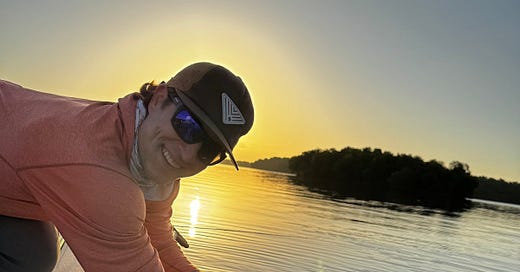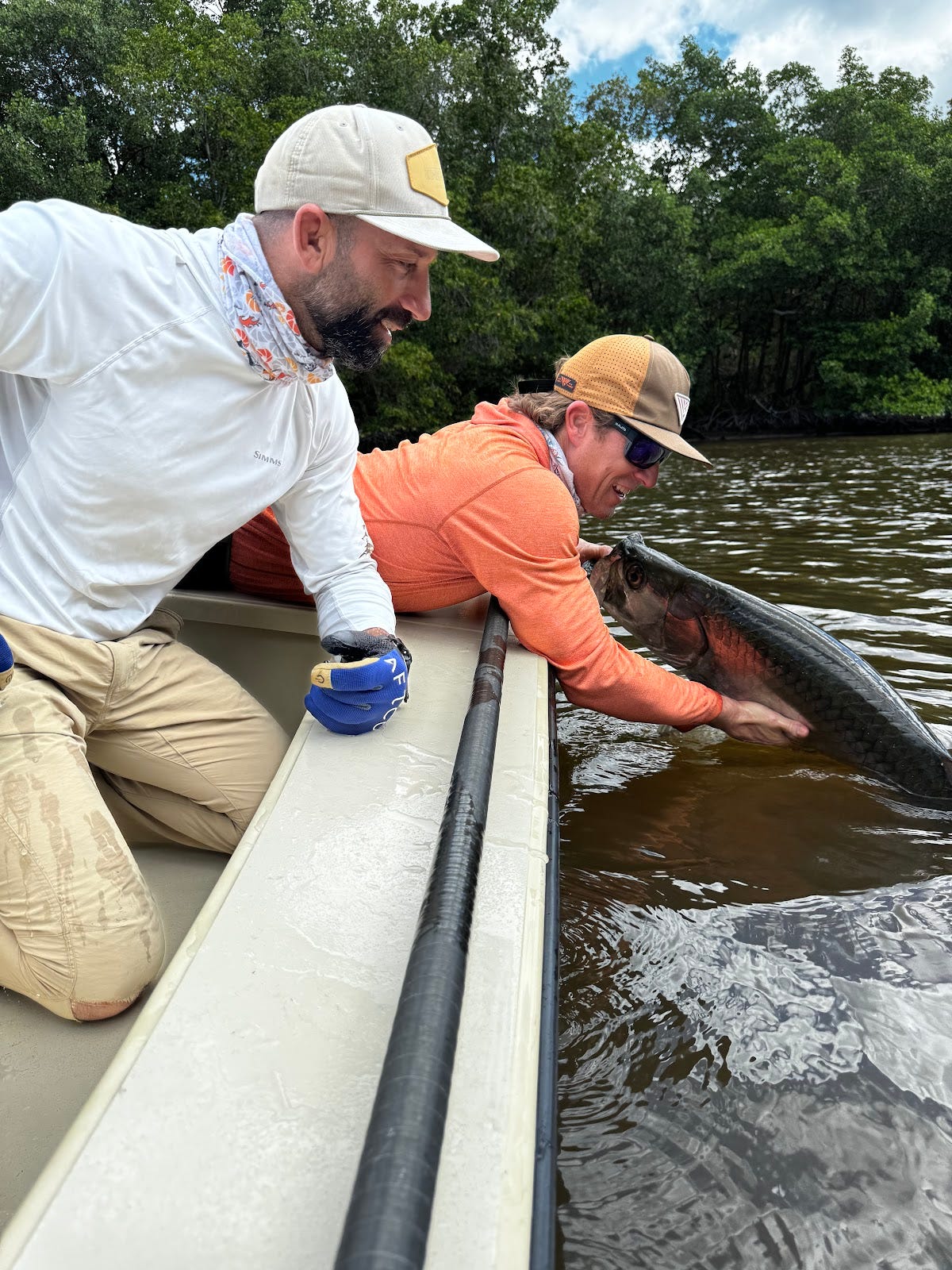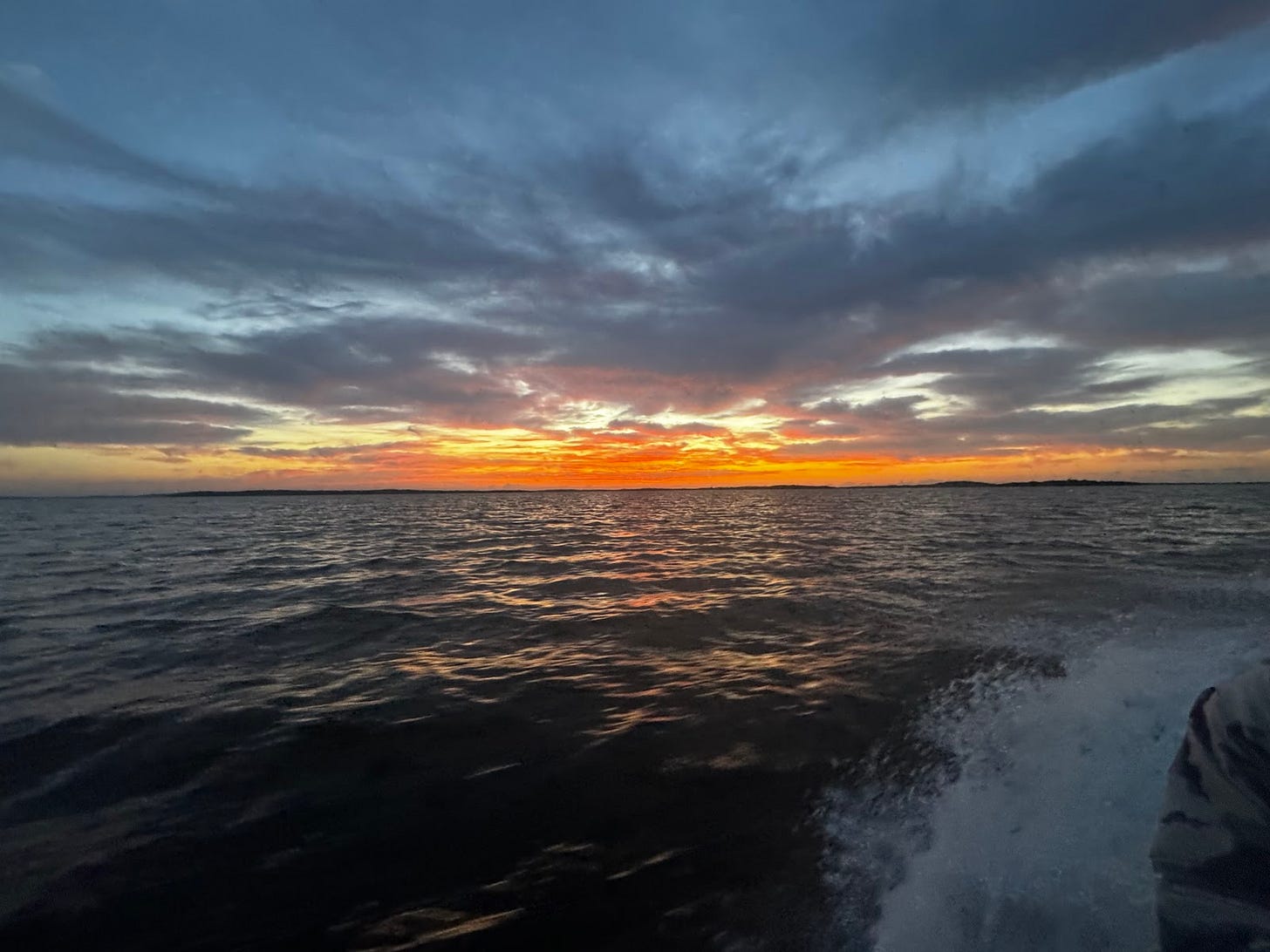Part 1: Cast. Strip. Cast. Strip. Forever.
Two days, no fish, and the quiet shame of being bad at something you care about.
TL;DR
It’s a 4-minute read—shorter than your last group text argument, and mildly more coherent.
Main Article
I thought I was ready.
I’ve fished before—plenty of times. But tarpon in the Everglades on a fly rod? Apparently that’s a different game.
This wasn’t a sightseeing trip. It became a four-day crucible in the Everglades—one forged with salt, silence, and sunburn—shared with a man I’d only just met and another I hoped to get to know better.
Jerry was our guide. Cuban-American, former wrestler, jiu-jitsu junkie, and a stone-cold badass on the water. He’s spent more than fifteen years guiding across South Florida, but fishing with Jerry, it never felt like a job he had to do. His voice changes when he talks about tarpon—like someone recounting a myth they still believe in. The fish, for him, aren’t a pastime. They’re sacred. Watching him scan the water, pole in hand, body coiled with attention, you realize: this man isn’t chasing a catch. He’s chasing communion.
Josh is my friend and early-morning workout partner. Every day at 5:30 a.m., we show up to the gym. Most mornings we workout side by side, grinding it out before the rest of the world wakes up. But on Thursdays, he shifts gears. He’s become our coach. Guiding us through lifts, correcting my form, pushing me a little farther than I thought I could go. Over the past year, we’ve logged thousands of reps, and a half-dozen coffees at Forager in Old Milford. That’s where the real friendship took root—in the connection over caffeine, when the workout was done but the game was just beginning. And during that time, I’ve come to respect him deeply—not just as a friend, but as a leader. A man whose presence carries weight, whose commitment to doing things the right way shows up in everything he touches.
Josh has been fishing with Jerry since 2017. It took him two, maybe three trips before he ever landed his first tarpon. So there was some history when I stepped onto the boat that first morning. I was the newcomer. The rookie. The one with something to prove.
They call tarpon the Silver King. If you’re lucky enough to hook one, you’ll know why.
But standing on the bow that first morning, rod in hand, sun just starting to lift off the water… I didn’t feel lucky. I felt outmatched.
Day One: Shallow Water, Deep Frustration
From the Everglades National Park boat launch, we headed east into the bay—water like glass, the wind barely a breath. I sat up front as Jerry navigated the skiff through water no deeper than a bathtub, scanning the horizon for shadows, tails, and flashes of silver as the sun rose over the mangroves.
Ten minutes into Day One, Josh was up on the bow and made a beautiful cast, the line unrolling like silk. The fly hit the water and—bam—tarpon on. It happened so fast it felt like fiction. A hookup in the first ten minutes of a four-day trip. 15 minutes later, I was taking a picture of the most glorious fish I’d ever seen with Josh grinning from ear to ear as the sun rose behind his head.
“AP, you’re up,” said Jerry. I quietly thought “I guess it's that easy.”
I’d fly fished before—plenty of times. I knew how to cast a fly rod. Or at least, I thought I did.
But this wasn’t a 6-weight on a mountain stream. This was a heavy saltwater rod, a thick fly line, a stout wind, and a much bigger fish. And when I stepped up on the bow, I lost everything—my rhythm, my timing, my technique. Gone.
My arms flailed like I was fighting off bees. I rushed every cast, overpowered every loop, and the line—God, the line—just collapsed in front of me. Weak, slack, impotent. I couldn’t find a cadence to save my life.
Nothing felt familiar. Nothing worked. And up on the front of that boat, exposed in the morning sun, I felt like I was drowning in my own self-consciousness.
Sometimes you fish for tarpon by sight, startled by the noise they make as they “roll” in the water. The start of my experience felt more like trying to read in a language I didn’t speak. I was a blind man in a bright place, casting wildly into sun glare and nerves.
Jerry would whisper: “Eleven o’clock, thirty feet, moving right to left. See the air bubbles?” I’d look up, rod ready—and see nothing.
When I did see one, I rushed the cast. The line piled up in a pile of failure. The fish vanished. Jerry kept his voice calm, but I could feel my chest tighten. That happened more than once.
Later that first day, we had shot after shot. Clean water. Rolling tarpon. I was in position. But I kept blowing it. Late casts. Poor placement. Fly too far, too short, or landing too loud.
At one point, I stripped the fly too fast and pulled it right out of a tarpon’s mouth who was actively hitting it. Jerry didn’t yell. He just exhaled through his nose and reset the boat.
There’s a framework I’ve used for years when helping people understand why we often fail at helping others learn in our organizations. I call it the “Leadership Square,” and I kept thinking about it that day.
It has four stages, laid out in a square:
Unconscious Incompetence — the top of the square.
This is where we all begin. Most of us are unconsciously incompetent at almost everything in the world—we’ve simply never had to do it before. We don’t know what we don’t know. And in that ignorance, there’s often a false sense of confidence.Conscious Incompetence — the right side of the square.
This is where the lights come on. Where you become aware that you have no idea what you’re doing or how to do it. It’s raw, ego-bruising, and deeply uncomfortable. Most people avoid this stage like the plague. But it’s also where learning actually begins.Conscious Competence — the bottom of the square.
You’ve begun to improve. You can do the thing—but only if you focus. You’re thinking actively about each step. It’s awkward. Halting. But it’s movement. You’re no longer lost—you’re just new.Unconscious Competence — the left side of the square. This is mastery. Not in the flashy, performative sense, but in the quiet ease that comes from repetition. It’s when someone picks up a fly rod and loads the line without effort. When a founder delivers a pitch that lands. When a CFO closes the books without breaking a sweat. They make it look easy—because they’ve earned that ease.
On that bow, Day One, I was squarely in stage two. Conscious incompetence. Fully aware of how bad I was, and how far I had to go. And the temptation, in that stage, is to overcorrect. To try too hard. To let ego drive the effort. I know because I’ve seen it in others. But now I was feeling it in myself.
Josh caught a second fish that afternoon, and this time I had more appreciation in the moment. Two tarpon in one day felt very special. Little did I know how special it actually was.
By the time we got back to the marina, I was quiet. Sunburned. Empty. No tarpon.
And totally addicted.
Day Two: Cast, Strip, Repeat
The next morning started beautifully—a soft sunrise over glassy water—but it quickly turned hard. The wind picked up. The clouds rolled in. Visibility dropped. And no matter who was on the bow, nothing moved. We couldn’t get a bite. Not a sniff. Not a single fish rolling.
We moved from the ocean back into the Glades. Then back out to the ocean. Then back into the Glades again. Jerry was trying everything, calling audibles, playing a bizarre game of hide and seek. But nothing was working.
It was six straight hours of casting for absolutely nothing.
Eventually we ended up in the bay, blind-casting, right up against the mangrove shoreline—reaching for shadows we couldn’t see, hoping something would break the silence.
Jerry eased the boat along the edge of a small island and let the current do the work, poling us within range of the trees. It was my turn on the bow.
My job was simple: land a fly every five feet along the mangrove roots. Strip it back. Watch for the flash.
And for the first time, something clicked.
Jerry would call out, “Green log!”—and I’d land the fly within inches of it.
A tight slot under a branch? I put it there.
Six inches off the shoreline? No problem.
I wasn’t good, but I wasn’t flailing. My hands moved without hesitation. My eyes started seeing the structure. I was beginning to understand the rhythm—cast, strip, breathe, repeat.
Josh and Jerry started teasing me. “Look who doesn’t know how to cast now!”
And they were right, I’d improved. Not perfectly. Not permanently. But meaningfully. I’d climbed a little to the right on the square. The shame was receding. In its place: quiet focus.
The Creek and the Close Call
Late in the day, we tucked into a shallow creek—a winding little cut through mangrove and mud. It felt different there. Still, almost eerie. The air hung thick, the sun heavy on our necks.
And suddenly, fish.
One swiped at my fly three times in a row. Fast, aggressive turns. I was too slow—or too dumbfounded—to land it.
Then Josh hooked up. Brief moment of glory. A run. A tug. Snap. The knot gave.
We cursed, laughed, reset. And that was the day.
The Ride Back
The run back to the dock took an hour and thirteen minutes. Jerry opened up the throttle and the boat slammed into every wave like it owed us money.
Saltwater stung my face. My shirt stuck to my back. I was bruised, battered, and empty-handed.
Two full days. Zero fish to the boat for me.
But something strange was happening inside me: I wasn’t bitter. I wasn’t discouraged.
I was… grateful.
To be here. To be trying. To be a beginner again.
We reached the marina just as the sun started on its downward trajectory, everything bathed in gold and soft shadow. The kind of light that quiets a person.
And I stood there for a minute, tired and silent.
No fish. But something deeper.
Something that only comes from loving something hard—and not quitting when it doesn’t love you back.
Two days down. No silver king yet.
But I had cast. I had learned. I had stayed in the boat.
And I had two more days to find out if that was enough.
(Part 2 next week)







